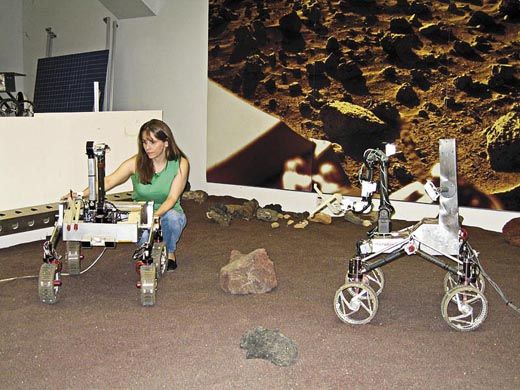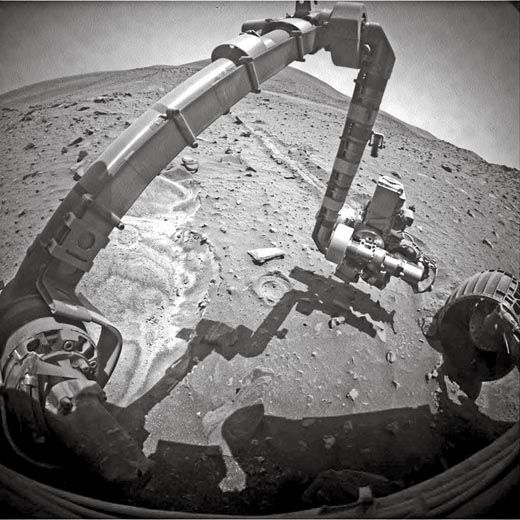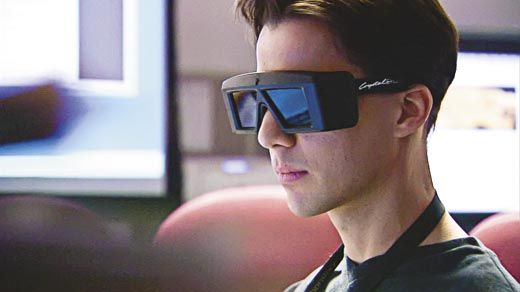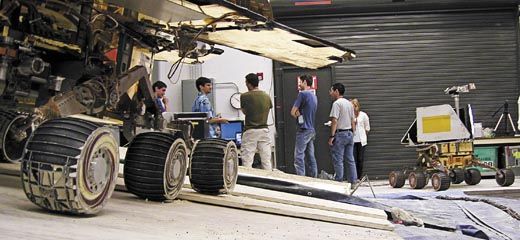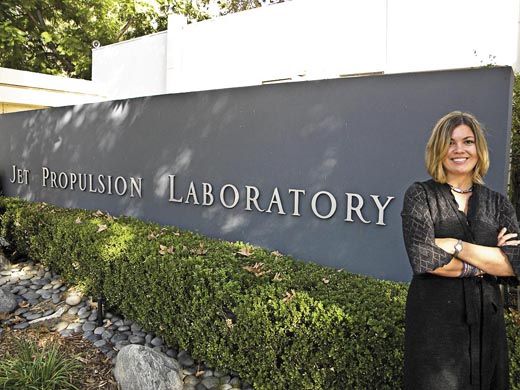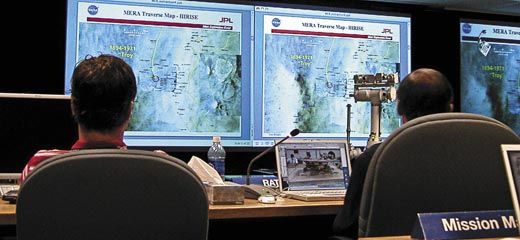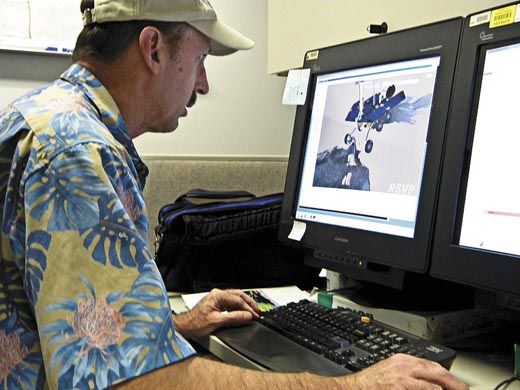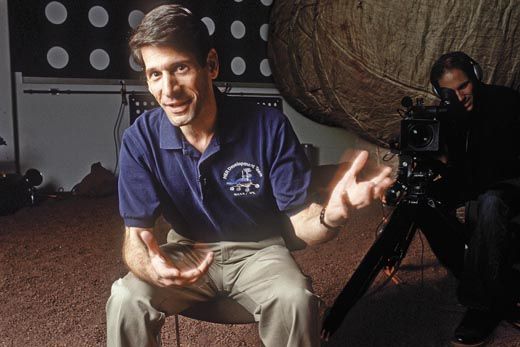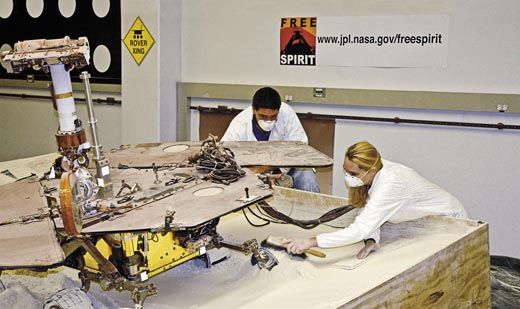Our Favorite Martians
For the scientists and engineers who drive the Spirit and Opportunity rovers, Mars exploration is personal.
/https://tf-cmsv2-smithsonianmag-media.s3.amazonaws.com/filer/Mars_Flash_Space_FM10.jpg)
In the summer of 2003, NASA’s Jet Propulsion Laboratory launched two robots to explore Mars. Named Spirit and Opportunity, they were born identical twins, but as they began to investigate opposite sides of the planet in January 2004, the four-foot-11-inch Mars Exploration Rovers developed distinct personalities: Spirit was a problem child and drama queen; Opportunity, a goody-goody and star performer. Both rovers, though, showed amazing durability. As the twins searched for water, they found the Fountain of Youth, living 24 times their intended 90 days. As they triumphed over one hazard after another, sending back wondrous images from another planet, those of us watching from Earth began to root for them and to consider the robustness of their engineering as “pluck.” In fact, when Spirit became stranded in deep soil last spring, the Planetary Society’s A.J.S. Rayl blogged optimistically that clean solar panels had made Spirit flush with power, and she spoke for all rover boosters when she wrote that the twins were now among “the community of planetary explorers deemed robot royalty.”
Maybe one reason for their success is that they’re so light on their feet, each weighing 400 pounds on Earth but just 150 pounds on Mars, which has 38 percent the mass of Earth. Another reason is luck. Martian wind coated the rovers’ solar panels with dust, ruining their capacity to draw energy, but then blew the dust off, enabling the solar cells to restore their vitality. And another reason is surely the ingenuity of the Jet Propulsion Laboratory scientists and engineers who built and operate the rovers, and have found clever ways to extend their lives as parts begin to break down. Whatever combination of luck and skill has made them successful, Spirit and Opportunity have deeply charmed the public.
One reason we’re hooked is that once the mission began, anyone with an Internet connection could get images of Mars. “The policy on the [rover] team to release images to the public as soon as they came down was a novel move,” says Janet Vertesi, a post-doctoral researcher in the Department of Informatics at the University of California at Irvine, who recently wrote her dissertation on the Mars Rover team’s operations. It was one of the first times NASA released photographs so quickly, she notes. “I think there was this excitement about being able to log on to the Web with your cup of coffee each morning and see what’s on Mars that day. Now with Twitter feeds, Facebook groups, [and] blog posts, that has snowballed.”
Vertesi’s graduate research, conducted at Cornell University in New York, grew out of her interest in the history and sociology of science. She is intrigued by human-computer interaction, and is delving into the social organization of robotic spacecraft teams, examining how scientists use images to do their work, she says. The Mars Exploration Rover Mission was ideal for her work. She was able to observe team members using images to analyze Martian geology and to interact with the planet through the rovers from millions of miles away.
To understand the scientist-rover connection, Vertesi became a participant-observer alongside scientists and engineers on the team, both at JPL, in Pasadena, California, and around the country. A Canadian citizen, she was restricted in where she could go at JPL; for instance, she could not enter rooms where controllers were issuing commands to the rovers. But she was given full access to the science team as they did their daily work on Mars, and got to know many science and engineering team members personally. (The science team is widely distributed, yet tightly woven through daily conference calls.)
She observed a complex relationship between the team and Spirit and Opportunity. “No one knows more than the drivers and scientists do that the rovers are not autonomous,” says Vertesi. “The team has to be very careful about what they tell them to do.” Her work, she states on her Web site, “brought up more questions than just about digital images.”At a 2008 conference in Italy, sponsored by the Special Interest Group on Computer Human Interaction, Vertesi presented a paper titled“ ‘Seeing Like a Rover’: Embodied Experience on the Mars Exploration Rover Mission,” in which she wrote, “While the Rovers are located millions of miles away from their human teammates, the scientists and engineers engaged in their daily operation have developed an uncanny sympathy for the Rovers that they credit as essential to mission success.”
Team members are happy to talk about this relationship. “You’re so involved with these machines that they sort of cease to be machines,” says Sharon Laubach, who holds a Ph.D. in robotics and is chief of the JPL group that develops the software instructions for the rovers. “We send them commands, like letters and missives, and they do what they want and write home at the end of the day. These girls are off on their own, and we hope they do what we ask them to.”
These girls. They’re not the first machines to attract emotional attachment from their handlers. Laubach recalls developing a strong bond with Rocky 7, a test-bed rover that never left Earth.
Spirit and Opportunity, by contrast, have endured nights of temperatures at –150 degrees Fahrenheit. Since day two, Opportunity’s arm has suffered a faulty shoulder joint. A bum wheel on Spirit has forced it torollbackwardsince2006, while more recently, another of its wheels began having problems turning. In 2005, Spirit scampered up Husband Hill—at 269 feet almost the height of the Statue of Liberty—all on borrowed time. There the rover took inspiring panoramas of the Martian landscape that no one had anticipated. The same year, Opportunity got itself marooned in soft soil at Purgatory Dune for a month and a half. A year before that, Spirit had turned its eyes to the sky and taken the only picture of Earth from the surface of another planet.
Last spring, NASA put out a press release that framed the rovers’ latest problems in unusually human terms: Spirit was “failing to wake up” from regular midday “naps” that conserve power. There were “bouts of amnesia” when Spirit didn’t record data from the day’s activities into solid-state memory. Both rovers showed “symptoms of aging.”
Laubach, who in the late 1990s worked on the Mars Pathfinder mission’s Sojourner rover, says that tiny vehicle stirred emotions too. “I definitely grew attached,” she says. “Sojourner was lower to the ground. Perhaps because of her size and limitations, I thought of her as a pet.
“Spirit and Opportunity”—she pauses—“are more human.”
Then, it happened. In late April 2009, as Doug McCuistion, director of the Mars Exploration Program, says, “Spirit did the equivalent of falling through the ice.”The rover inched up onto what no one realized was a brittle crust, and fell through into flour fine dirt. In the low gravity and atmospheric pressure, the bone-dry fluff gulped the wheels down with each effort to get out, while a menacing rock tickled the rover’s belly. A 12-degree tilt didn’t help matters. After Spirit’s 40 months and 4.3haltingmiles, at never more than 0.1mph, the team declared a halt and spent half a year working with a full-scale simulation rover in a sandbox at JPL.
In late November 2009, the team began sending new commands to Spirit, to no avail. By late December, the rover had hardly budged. With the winter sun dropping steadily toward its solstice on the northern horizon, the southern-hemisphere- dwelling rover needed to find a slope that would tilt its arrays north. The team fretted anew that Spirit might not survive the winter.
“I think it’s largely the time that people have devoted to this project that has really created this bond,” says Ashley Stroupe, a rover driver. “We’ve been working with these rovers, some of us now, for 10 years, and myself for five.” Stroupe did not anticipate the affection she feels. “I didn’t know that I’d have the time to get to know the rovers this well.” She says that the team is emotionally invested in the welfare of the vehicles, that they’re “proud” of them. “In many ways,” she says, “we think of these rovers kind of as our children that we sent off into the world way too early. And like most parents, when their kids go off to college, we can’t reach out to help them every time that they really need us.”
Vertesi takes it one step further. In her “‘Seeing Like a Rover’ ” paper, she claims the controllers not only have an anthropomorphic view of the rovers, but also a “technomorphic” shift in their own behavior.
“It’s hard for us to understand the experience of these robots that are so far away from us,” says Vertesi. “ So the scientists and engineers do the ‘rover dance.’ It’s a series of gestures that imitate the rover actions: unfurling of arms and rotating of wrists; splaying of arms behind them like solar panels. Always very aware of where the sun is. These people have a semi physical presence on Mars. One scientist got up and was talking about an observation and he began to shuffle backward…and then he said, ‘Janet, get your camera. I’m turning into the rover!’ ”
Driver John Wright confesses to some of it. “The thing I always notice is that I have to mentally visualize what the [rover] arm is doing. And I have to use my left arm. When I’m talking about it, I start with my right arm, and then I say, Wait, I have to use my left arm, because the shoulder joint’s on the left front side of the rover, and the elbow sticks out to the left. So you’re sticking your thumb out, wrapping the arm around. And turning the wheels. There’s definitely a lot of hand-waving.”
The Pancams are the eyes, says Vertesi, and they’re often talked about as such. “The rover team says, ‘We’ll look around a bit.’ When they look down, they say, ‘We’re looking between our feet.’ It pulls that rover down into the human space.”
And it sends driver Scott Max well up into the Martian space, thanks to pairs of cameras on each rover thatrecordimagesin3-D.“When I’m looking through these 3-D goggles, I’m looking at the Mars I would see if I were standing there and looking with my own eyes,” says Maxwell. “Then I can use all the stuff evolution put into my brain to think about that 3-D world...shape of the terrain, the height of obstacles, and so on, so that I can plan a safe path for the rover. It’s surprising how many dangers and insights pop out at you when you look at the terrain in 3-D that just aren’t apparent in2-D.Trywalking around for a day with one eye closed and you’ll see what I mean.”
Human-robot interactions create very real bonds. U.S. military personnel in Iraq and Afghanistan grow attached to their comrade robots, which sniff out improvised explosive devices and often lose their mechanical limbs in the process. The machines get names, faux Purple Hearts, battle field “promotions,” and major repairs—or somber memorials.
And there are increasing numbers of robots at home. A group of scientists at the Georgia Institute of Technology, which offers one of the nation’s top two robotics programs, recently produced a paper, “‘My Roomba Is Rambo’: Intimate Home Appliances.” Apparently the lowly vacuuming robot called the Roomba generates rover-like devotion. “The majority of our participants described Roomba as some form of household companion with lifelike properties,” the authors wrote, “such as ‘a helpful assistant,’ ‘a pet like being,’ and ‘a valuable family member.’ Perhaps somewhat extremely, three participants actually listed their Roombas (including their names and ages) as family members when we asked them to provide demographic information…. Eighteen participants felt that Roomba had intentions, feelings, and unique characteristics. One participant…felt that each unit had a unique personality although he was well aware that technology had not advanced that far….”
These military and civilian admirers get to touch the objects of their affection. By contrast, the JPL controllers get at best within 34 million miles of Spirit and Opportunity, once every two years.
“We imagine how the rover might feel,” says John Grant, a geologist and chair of the Center for Earth and Planetary Studies at the National Air and Space Museum. Grant is one of 14 chairpersons of the Science Operations Working Group, responsible for leading day-to-day science planning for the rovers. He’s worked with the rovers since 2002. “I don’t think of them as pets,” says Grant. “And I don’t think of them as people. But I definitely give them personalities.” He thinks their mobility has something to do with it. “The Phoenix and Viking landers were tremendous successes. But they were stationary, so maybe they’re more mechanical. Spirit and Opportunity, they’re more like the Little Engines That Could, because they’ve done so many things we’ve asked of them that are beyond original expectations.”
The mystique of the rovers has even touched Native American culture. Tim McCoy, a geologist at the Smithsonian Institution’s National Museum of Natural History, has been on the rover team for the last four years. He’s also a citizen of the Miami tribe from the Midwest. In their Algonquian language, explains McCoy, the Miami confer “animacy” on certain beings, such as people, animals, some plants, and ome natural phenomena, such as thunder. “Anthropomorphizing is not the right word,” he says. “It’s hard to describe. Some things have a living force to them, a spirit of sorts.”The Miami elders decide what types of modern technology have animacy. Cars do. Trains don’t. “I had heard Janet Vertesi talk in a rover team meeting about the boundary in her mind between people and machines,” says McCoy. “She was sort of struggling with that. But from a Native American sense, there’s no struggle there, no apparent conflict.”
McCoy and a Miami tribesman colleague who is a linguist at Miami University of Ohio debated whether the rovers had animacy. They went to a tribal elder and described what a rover is and how it works with humans. The elder pondered the question, then proclaimed that the rovers have animacy. A group of about 20 undergraduates from theMiami tribe at the university then named the rovers “neehpikalaankwa keeyosia,” or “the red star wanderer.” “To the Miami,” says McCoy, “the wanderer performs an important task as he or she gathers useful information during wanderings and brings it back for the community.”
McCoy shared the story with the rover team.“They weren’t surprised. You really feel like this thing is an extension of you. When one of them dies, there’s going to be a tangible loss and a period of grieving.”
End-of-life questions make anyone close to the rovers uneasy. Yet with Spirit’s recent stranding, the scientists are often asked about the inevitable.
“They talk about them as geriatric,” says Vertesi. “Amnesia. Arthritis. All very human experiences. But to mention a rover death....The pressure to preserve the rovers is huge.”
John Grant is practical about the demise of the probes, but says they’re not there yet. “I know it will happen someday, but I don’t want to think about the eventual end of the mission,” he says. “With the rovers, it’s open-ended. You don’t want to let go of them.”
A stationary Spirit or Opportunity is far from dead. Instead, the rover becomes like the Phoenix lander, which, after touching down in the Martian far north in May 2008, detected snowfall and clear evidence of water ice, and made it to early November, well past its 90-day projection, before waning sunlight caused a loss of contact. Or it becomes like the two Viking landers launched in themid-1970s, which studied the chemistry, meteorology, seismology, and magnetism of their Martian environments while searching for signs of microbial life, and lasted almost 10 years combined. Phoenix and Viking never budged from their landing spots. Spirit could be very valuable, say, as a climate station for months to come. “There’s a whole list of geodynamic measurements that we can use that you need a stationary vehicle [for], to track the radio signals to explore the geodynamics of Mars,” says JPL rover project manager John Callas. “And we also have an ability to do a crude seismometry with the rover. So those are both long-term objectives, new things that the rover can do.” Bottom line: It’s unthinkable that NASA would abandon a half-billion-dollar rover with almost all systems working just because it can’t rove.
So while Spirit continues to worry the team, Opportunity has a good chance of surviving another Martian winter as it rolls south toward Endeavour Crater, its biggest crater yet. It will need more than one Earth year to get there. When the fateful day comes and the Mars rovers cease to transmit, perhaps the JPL folks will be emotionally prepared, and will focus on Earthly companions: cars, pets.
“I have two cats,” says Sharon Laubach. “Our rovers follow orders better than cats do.”
Michael Klesius is an Air & Space/Smithsonian associate editor.
